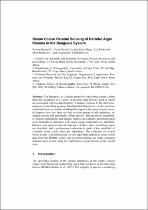JavaScript is disabled for your browser. Some features of this site may not work without it.
- ResearchSpace
- →
- Research Publications/Outputs
- →
- Book Chapters
- →
- View Item
| dc.contributor.author |
Bernard, Stewart

|
|
| dc.contributor.author |
Pitcher, G

|
|
| dc.contributor.author |
Evers-King, H

|
|
| dc.contributor.author |
Robertson, L

|
|
| dc.contributor.author |
Matthews, M

|
|
| dc.contributor.author |
Rabagliati, A

|
|
| dc.contributor.author |
Balt, C

|
|
| dc.date.accessioned | 2015-10-16T05:47:30Z | |
| dc.date.available | 2015-10-16T05:47:30Z | |
| dc.date.issued | 2014 | |
| dc.identifier.citation | Bernard, S., Pitcher, G., Evers-King, H., Robertson, L., Matthews, M., Rabagliati, A. and Balt, C. 2014. Ocean colour remote sensing of harmful algal blooms in the Benguela system. In: Remote Sensing of the African Seas. Springer Netherlands | en_US |
| dc.identifier.isbn | 978-94-017-8007-0 | |
| dc.identifier.uri | http://link.springer.com/chapter/10.1007%2F978-94-017-8008-7_10 | |
| dc.identifier.uri | http://hdl.handle.net/10204/8196 | |
| dc.description | Copyright: Springer Netherlands. Due to copyright restrictions, the attached PDF file only contains the abstract of the full text item. For access to the full text item, please consult the publisher's website. | en_US |
| dc.description.abstract | The Benguela, as a highly productive upwelling system, suffers from the occurrence of a variety of harmful algal blooms, most of which are associated with elevated biomass; a feature common to the shelf environment of upwelling systems. Most harmful blooms have in the past been attributed to one or another dinoflagellate species, but more recently harmful impacts have also been ascribed to other groups of phytoplankton, including diatom and autotrophic ciliate species. Typical bloom assemblages, forcing mechanisms and harmful impacts are outlined, and bloom types most amenable to detection with ocean colour radiometry are identified. Inherent and apparent optical properties of these algal assemblage types are described, and a preliminary evaluation is made of the suitability of available ocean colour data and algorithms. The evolution of several bloom events is described using various algorithms applied to ocean colour data from the Medium Resolution Imaging Spectrometer (MERIS), and recommendations are made about optimal ocean colour usage for high biomass algal blooms in coastal zones. | en_US |
| dc.language.iso | en | en_US |
| dc.publisher | Springer Netherlands | en_US |
| dc.relation.ispartofseries | Workflow;14751 | |
| dc.subject | Benguela | en_US |
| dc.subject | Harmful algal blooms | en_US |
| dc.subject | Dinoflagellate species | en_US |
| dc.subject | Medium Resolution Imaging Spectrometer | en_US |
| dc.subject | MERIS | en_US |
| dc.subject | Coastal zones | en_US |
| dc.title | Ocean colour remote sensing of harmful algal blooms in the Benguela system | en_US |
| dc.type | Book Chapter | en_US |
| dc.identifier.apacitation | Bernard, S., Pitcher, G., Evers-King, H., Robertson, L., Matthews, M., Rabagliati, A., & Balt, C. (2014). Ocean colour remote sensing of harmful algal blooms in the Benguela system., <i>Workflow;14751</i> Springer Netherlands. http://hdl.handle.net/10204/8196 | en_ZA |
| dc.identifier.chicagocitation | Bernard, Stewart, G Pitcher, H Evers-King, L Robertson, M Matthews, A Rabagliati, and C Balt. "Ocean colour remote sensing of harmful algal blooms in the Benguela system" In <i>WORKFLOW;14751</i>, n.p.: Springer Netherlands. 2014. http://hdl.handle.net/10204/8196. | en_ZA |
| dc.identifier.vancouvercitation | Bernard S, Pitcher G, Evers-King H, Robertson L, Matthews M, Rabagliati A, et al. Ocean colour remote sensing of harmful algal blooms in the Benguela system.. Workflow;14751. [place unknown]: Springer Netherlands; 2014. [cited yyyy month dd]. http://hdl.handle.net/10204/8196. | en_ZA |
| dc.identifier.ris | TY - Book Chapter AU - Bernard, Stewart AU - Pitcher, G AU - Evers-King, H AU - Robertson, L AU - Matthews, M AU - Rabagliati, A AU - Balt, C AB - The Benguela, as a highly productive upwelling system, suffers from the occurrence of a variety of harmful algal blooms, most of which are associated with elevated biomass; a feature common to the shelf environment of upwelling systems. Most harmful blooms have in the past been attributed to one or another dinoflagellate species, but more recently harmful impacts have also been ascribed to other groups of phytoplankton, including diatom and autotrophic ciliate species. Typical bloom assemblages, forcing mechanisms and harmful impacts are outlined, and bloom types most amenable to detection with ocean colour radiometry are identified. Inherent and apparent optical properties of these algal assemblage types are described, and a preliminary evaluation is made of the suitability of available ocean colour data and algorithms. The evolution of several bloom events is described using various algorithms applied to ocean colour data from the Medium Resolution Imaging Spectrometer (MERIS), and recommendations are made about optimal ocean colour usage for high biomass algal blooms in coastal zones. DA - 2014 DB - ResearchSpace DP - CSIR KW - Benguela KW - Harmful algal blooms KW - Dinoflagellate species KW - Medium Resolution Imaging Spectrometer KW - MERIS KW - Coastal zones LK - https://researchspace.csir.co.za PY - 2014 SM - 978-94-017-8007-0 T1 - Ocean colour remote sensing of harmful algal blooms in the Benguela system TI - Ocean colour remote sensing of harmful algal blooms in the Benguela system UR - http://hdl.handle.net/10204/8196 ER - | en_ZA |






